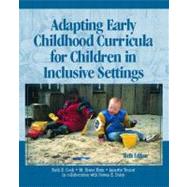
| Providing for Special Needs in Early Education: The Challenge | |
| In Partnership with Families | |
| Recognizing Special Needs and Monitoring Progress | |
| Developing Individualized Intervention Plans and Programs | |
| Implementing Intervention and Instructional Strategies | |
| Promoting Social and Emotional Development | |
| Helping Young Children Develop Motor Skills | |
| Nurturing Communication Skills | |
| Encouraging the Development of Cognitive Skills and Literacy | |
| Providing Inclusion Support to Young Children with Special Needs in Community-Based Settings | |
| Appendix A: | |
| Appendix B: | |
| Appendix C: | |
| Appendix D: | |
| Appendix E: | |
| Appendix F: | |
| Appendix G: | |
| Appendix H: | |
| Appendix I: | |
| Appendix J: | |
| Glossary | |
| Name Index | |
| Subject Index | |
| About the Authors | |
| Table of Contents provided by Publisher. All Rights Reserved. |
The New copy of this book will include any supplemental materials advertised. Please check the title of the book to determine if it should include any access cards, study guides, lab manuals, CDs, etc.
The Used, Rental and eBook copies of this book are not guaranteed to include any supplemental materials. Typically, only the book itself is included. This is true even if the title states it includes any access cards, study guides, lab manuals, CDs, etc.